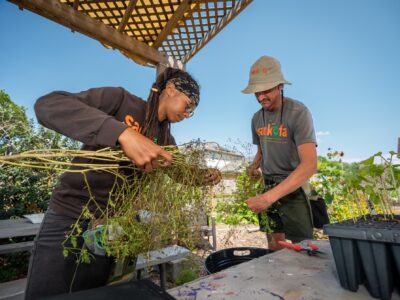Numerous organizations nationwide are supporting farmers markets to encourage their growth and community interaction. These groups offer not only local resources but also clarity and guidance on federal programs, including the Supplemental Nutrition Assistance Program (SNAP), the Special Supplemental Nutrition Program for Women, Infants, and Children, and the Senior Farmers Market Nutrition Program.
States, including Maine, California, Pennsylvania, Wisconsin, Minnesota, Michigan, Alaska, and Mississippi, have robust organizational support for farmers markets, which are growing in popularity nationwide as consumers look for healthier and more sustainable food sources. The number of farmers markets in the United States has grown rapidly in recent years, from nearly 2,000 in 1994 to more than 7,000 currently registered in the U.S. Department of Agriculture (USDA) Farmers Market Directory.
On the national level, The National Farmers Market Coalition is a nonprofit with a mission to strengthen farmer’s markets across the U.S.
The coalition works to ensure farmers earn fair prices, consumers have access to nutritious, local produce, and communities regain a “town square” approach due to the foot traffic generated by the markets.
Similarly, with support from the Robert Wood Johnson Foundation and in partnership with Columbia University, the Project for Public Spaces examines strategies for implementing farmers markets in low-income communities. It also explores barriers that need to be addressed to improve the viability of marketplaces in these areas. The project works with communities to transform public spaces into vital spaces serving common needs. According to its website, it has helped more than 3,500 communities in 50 countries and all 50 states do this.
Photo Courtesy Project for Public Spaces
Maine is setting a great example with the Maine Federation of Farmers Markets. The group helps sustain Vacationland’s 115 summer and 30–35 winter farmer markets and widens access to locally grown food for all state residents. The group organizes programs, including an annual convention, and offers technical and financial services. Federal SNAP participants can access Maine Harvest Bucks, which stretch SNAP dollars and allow low-income consumers to make healthy choices.
Photo Courtesy Maine Federation of Farmers Markets
In California, the California Nutrition Incentive Program focuses on state-grown fruits, vegetables, and nuts. The organization provides grant funding and supports various low-income programs. On a more local scale, Kaiser Permanente holds farmers markets at various medical centers and works with the Community Alliance with Family Farmers and the Bay Area Physicians for Social Responsibility to encourage healthcare institutions to purchase sustainable and locally grown produce around San Francisco.
Also, in the Bay Area, the Pacific Coast Farmers’ Market Association creates community-based food experiences that support California family farms.
Pennsylvania offers numerous organizations for farmers markets. The Turnpike Plaza Farmers’ Market Program provides support for farmers and promotes Pennsylvania-produced agricultural products. The state also assists with the Senior Farmers’ Market Program, which provides eligible seniors with checks to purchase produce grown in Pennsylvania.
North and west in Wisconsin, the Wisconsin Farmers Market Association encourages and supports locally-produced foods and products. Neighbor Michigan also offers important support for local growers, where the Cottage Food Law allows producers to make non-potentially hazardous food items in their home kitchen, which is not licensed by the state, and sell them directly to consumers. The Michigan Farmers Market Association works with organizers, managers, farmers, and vendors “to create a thriving marketplace” for local agricultural products in the state.
In nearby Minnesota, Minneapolis launched a simple permitting process so small farmers markets can thrive. Additionally, Homegrown Minneapolis works to expand the city’s ability to grow, process, distribute, eat, and compost more healthy, sustainable, and locally grown foods.
Photo Courtesy The Michigan Farmers Market Association
In “The Last Frontier,” the Alaska Farmers Market Association assists all member markets, while the National Young Farmers Coalition supports Alaska’s beginning and young farmers.
In the Deep South, the Mississippi Certified Farmers Market program — created by the Mississippi Department of Agriculture and Commerce — promotes a place for Mississippi-grown fruits, vegetables, and plants. The Blue Cross & Blue Shield of Mississippi Foundation also supports farmers markets by offering an official brand, the Mississippi Certified Farmers Market. The company also provides various grant funding opportunities to start a farmers market or enhance existing ones.
Photo Courtesy The National Young Farmers Coalition
“I invite all Mississippians of every background to work in unity to strengthen and grow agriculture, the state’s largest economic sector,” Andy Gipson, Mississippi’s commissioner of agriculture and commerce, said on his agency bio page. “Let’s keep on working together and pulling [in] the same direction.”
With the popularity of farmers markets on the rise, these organizations are important to their growth. Whether helping farmers get their produce into the right venues or assisting SNAP customers with benefits, each organization is helping grow better access to healthy, nutritious, local, and sustainable food for all Americans.





